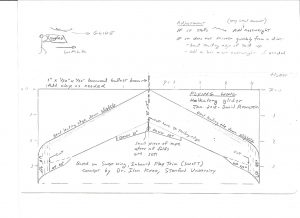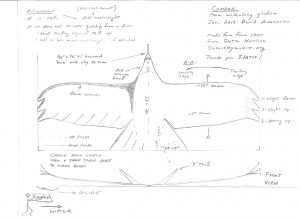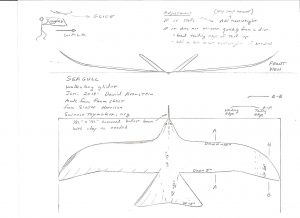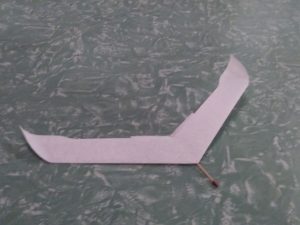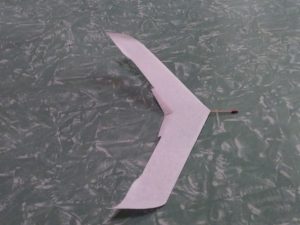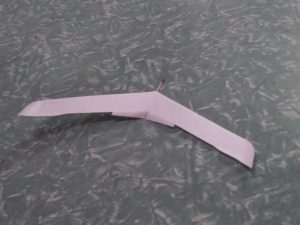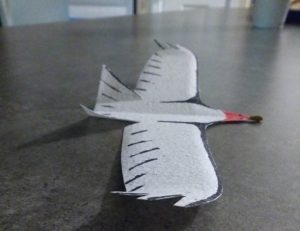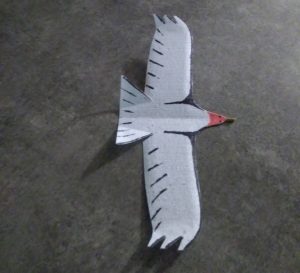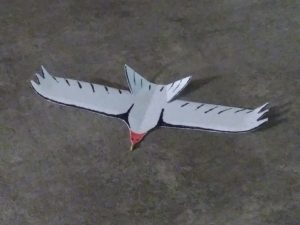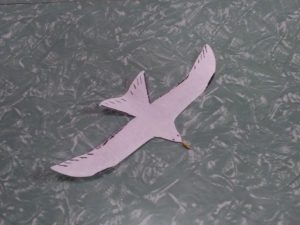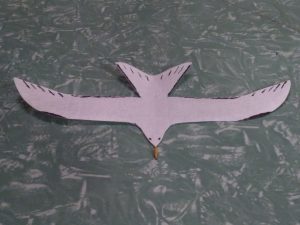- Here are a few of David’s plans: Club Racer, F-89, Red Flying Wing , DC3 and Slow Surfer.
- Beautiful Bird Walkalong Gliders from David Aronstein
Dr. David Aronstein is famous for his balsa and tissue walkalong glider creations. But it was a surprise when he made some foam gliders. And so worth the wait; check out his beautiful bird creations!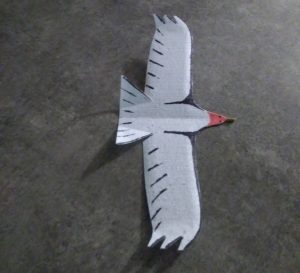
New: David wrote a really great article about walkalong gliders for the National Free Flight Society‘s (NFFS) Symposium.
David’s article is a hoot to read, right from the first paragraph. He writes from his extensive experience–not only designing and building walkalongs, but also organizing fun events.
NFFS retains the copyright to the article and I’m grateful that they and David are sharing it. It’s so hard to summarize what NFFS does because there are so many cool things. Maybe “crafted flying magic”! Just click and check them out. NFFS is friendly and welcoming of new people and you’ll love their YouTube channel.
Transcript
This video is an interview with one of the major innovators of surfing objects on waves or air, but first an introduction. David Aronstein is so modest that I corresponded with him for years before I knew that it was Dr. David Aronstein. He has made model airplanes forever and is now an aerospace engineer. He still makes magnificent model flying machines. Successful walkalong gliders had always been of the “flying wing” variety until David figured out what he had to do to get a traditional-looking plane with a tail section to fly as a walkalong glider. That opened up a whole new branch of flying. He also organized walkalong gliding events where people careened though obstacle courses or flew missions. He has been a mentor to Michael Thompson, the engineering student who developed thin foam jagwing gliders, and getting him an internship at the Hawker-Beechcraft aircraft company.
(in answer to a question about how he got airplanes with tails to fly as walkalong gliders when everybody else was using the “flying wing” design)
Well, first of all it’s worth mentioning that somebody [Joseph Grant] patented what are essentially walkalong gliders in 1955 and his sketches show a tail. We don’t know if his flew successfully. We only know he made sketches, we don’t know what he did with it. My path to doing what we do was that I heard of Tyler MacCready’s concept and invention sometime around 1990 and it sounded cool so I thought I’d try it.
I had been active building indoor and outdoor free flight—primarily rubber powered—models for most of my life. I knew the building technology that was familiar to me, which was balsa wood and tissue paper. Before I built anything I took an indoor hand-launch glider which is designed to be very stable in free flight but it has a long tail moment arm. I tried to fly it on a board and promptly planted it into the ground, very decisively—nose dive.
I realized that’s because the wing and the tail, flying in front of the board, the tail is getting more upwash than the wing because it’s closer to the board. The logical step was, “Ok, let’s try a flying wing.” I built a couple of stick and tissue flying wings with about a 16 inch wing span. I started taking them to indoor model airplane meets and people had a lot of fun with them. I could fly them with a board. Some guys learned to fly them on their forehead or with their hands.
That was it for me for a long time. That was around 1990. Early 2000 as my kids were getting old enough to enjoy model airplanes and were coming to meets with me, I thought, “To make this more fun for them it’s time to try this again.” So I built a couple of flying wings again and that was fun. They were kind of hard to steer, so I experimented with putting vertical surfaces on them. But kids like things that look like real airplanes.
I’d always thought that maybe one with a tail would work if you made the tail close-coupled to minimize the flow distance between where the wing is and where the tail is. And even high, like a Tee tail. So with a traditional free flight model with the wing and tail far apart, there’s no way to get a board under it and get the same amount of upflow in both places. But it makes sense that if you put the wing and the tail closer together, and maybe staggered vertically with the tail higher than the wing, the board is here. You get your wing a lot closer to the board and get much more equal upflow on both surfaces. That means much less trim change between free glide and gliding in front of a board.
That was just an idea that I had when I first did flying wings but it was worth a try. I built a semi-scale model of a Northrop Scorpion, a 1950s military jet with a small, close-coupled high tail. So it had all the right ingredients that I thought were necessary and—sure enough—it flew. It flew very well. I still have it. I built it around 2003 and now it’s 2010 it’s been through a lot, but the good thing about these scratch-built balsa wood models is that you turn them from a pile of sticks into an airplane once to build them. You can do it again if you have to to repair them.
There is a large hall next to the cafeteria where I work, which is Hawker Beechcraft company. I fly rubber powered models there but it’s a little bit frustrating because it’s drafty and if you get too close to the ceiling there are hanging-up hazards. When I took a walkalong glider there and spent my lunch break flying missions back and forth across this hall—strafing some of the constructs that are at one end, having fun, not winding up a rubber band for the whole time—I realized that there was something good here. Then I started inviting some of my friends and coworkers. Then we started having informal meets where we would have obstacle courses.
With rubber-powered free flight that I do is all about duration, but with walkalong gliding you can do more task oriented things that are fun. You can share models. It doesn’t matter who built them because the skill of flying them is a big part of it. They are low labor-hours to construct so you don’t mind if they get broken. And it’s just a lot of fun! My son Jesse would come to some of these meets and about the second season of coming he started winning all the events. We had to have an altitude contest just so that the grownups would have a chance. Now he’s getting tall enough I don’t think that will help anymore.
We’ve done a lot of creative things: obstacle course, passing the glider back and forth between two pilots seeing how many times you can do that in a minute, a strike mission where you fly the length of the hall, make target passes, fly back and make a carrier landing.
(I ask David’s son Jesse about his airplane adventures)
When I was really little I started flying rubber-powered model airplanes with my dad. Then he started making these walkalong gliders so I flew those. It took awhile but I eventually became ok at it. Now I suppose I can fly them pretty well. They’re very fun.
There also some contests that my dad has at his job. I go there and win most of them, which is fun. I like the long-range strike where you go and bomb the target, come back and land on the aircraft carrier. I think that’s very fun. I also like the one—I forget what it’s called—you have to stay up for two minutes. If you do, you qualify for the speed race. Basically I like all of them except the altitude contest. [David, off camera: You’re getting taller now, so maybe you’ll get your revenge.] Yeah, I’m still not as tall as most of the grownups, though. But in a little while maybe I will be.
The first airplane I made was a B-17. It has four propellers that spin and it flies pretty well. [David, off camera: Where did we get the ideas for the spinning propellers?] Mike Thompson. He made a little foamy with a little spiny propeller. Then I also made a 3 dimensional F9F Cougar. That one contest where you stay up for two minutes to qualify for the speed race, I flew that and it was kind of difficult because it’s so fast.
(I thank Jesse for helping at the St Louis Science Center during SciFest)
You’re welcome. Yeah, it was fun. I enjoyed teaching everyone how to fly. Hopefully at least one person that I taught can do it ok now.
(David and his younger son Zevi now on camera)
David: I’ll say a little about Zevi. When Jesse would come to the glider meets at work, Zevi would come too. Zevi liked to fly the Z surfer. It’s a stick and plastic covering, our version of the classic foam glider that Tyler MacCready was shown with on TV. (End of interview)Aronstein Article NFFS Sympo 53
Beautiful Bird Walkalong Gliders from David Aronstein
Dr. David Aronstein is famous for his balsa and tissue walkalong glider creations. But it was a surprise when he made some foam gliders. And so worth the wait; check out his beautiful bird creations! ( Click for larger images)

